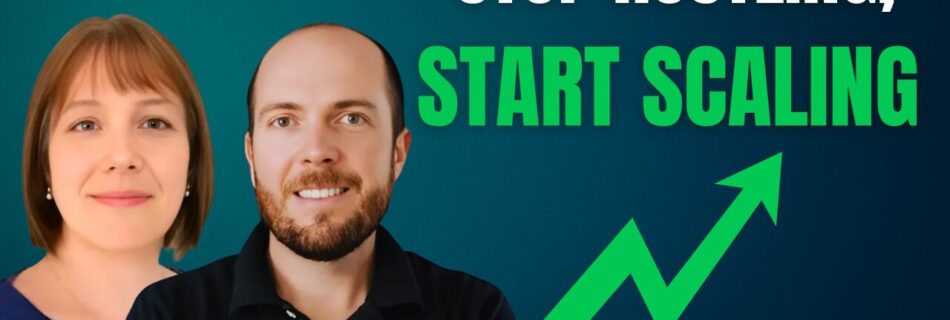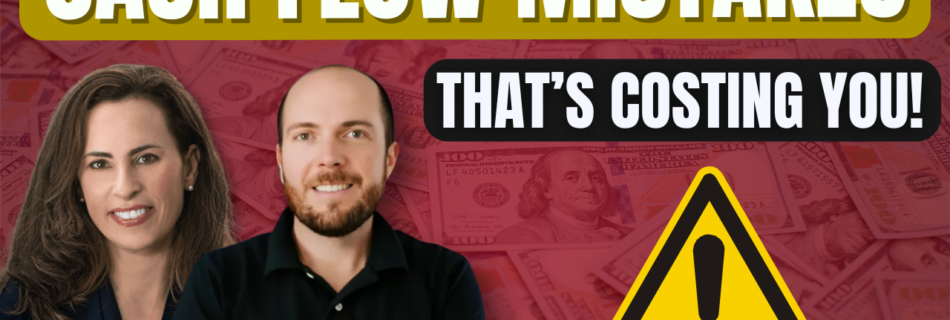How to Avoid Hiring Mistakes When Scaling Your Business (with Lynn Talbott)
Hiring during a growth phase can feel like a scramble. You’re stretched thin, juggling sales, operations, and your team — and suddenly you need someone yesterday. But rushing the hiring process can quietly sabotage your company’s momentum.
In a recent episode of the Scale Smart Grow Fast podcast, host Harley Green sat down with Lynn Talbott, founder of The Bookkeeper’s Coach, to break down how to avoid the most common hiring pitfalls that hurt growing businesses.
Preferred listening on the go? Catch the full podcast episode on Spotify and Apple Podcasts.
Here are the top takeaways every founder needs to hear:
1. Your First 5 Hires Are Make-or-Break
Lynn compares early hires to “cornerstones” of your company. They shape your culture, pace, and scalability. Hiring someone who can’t grow with your business — even if they solve an immediate pain point — will cost you more in the long run.
✅ Tip: Think 3–5 years ahead when hiring. Choose people who can evolve with the company, not just fill a gap today.
2. Don’t Just Delegate—Lead
Founders often struggle with delegation — or worse, fall into abdication (handing something off and walking away). Lynn emphasizes the need to develop leadership in your team. Your hires should lighten your load, not add to it.
✅ Tip: Hire with leadership potential in mind. Can they take ownership, or will you be babysitting?
3. Culture Fit > Technical Fit
Many entrepreneurs rush into hiring someone with the right skills — but overlook cultural alignment. That’s a fast track to team dysfunction.
✅ Tip: Define your mission, values, and team vibe. Then hire people who live them, not just talk the talk.
4. Watch Out for the “Halo Effect”
One of the biggest mistakes? Letting your gut override structure. Entrepreneurs often make a snap judgment and then spend the rest of the interview convincing themselves the candidate is “the one.”
✅ Tip: Use structured interviews with behavioral questions. Stick to a checklist. Don’t wing it.
5. Don’t Hire Just Because You “Trust” Someone
Hiring a friend, family member, or neighbor because you “trust” them — not because they’re qualified — is a common trap Lynn warns against.
✅ Tip: Trust is great, but competency and fit are non-negotiable. Hire based on merit, not convenience.
6. Hire Slow, Fire Fast
If you realize you’ve hired the wrong person, act quickly. Avoid dragging out the pain — it affects your team, your culture, and your momentum.
✅ Tip: Have open conversations early. If it’s not working, make the call and move forward.
Final Thought: Structure Doesn’t Have to Feel “Corporate”
Many founders resist structure, thinking it will kill their creative edge. But according to Lynn, a bit of structure — especially around hiring — actually frees you up to lead and grow.
🔗 Resources & Links
- Lynn Talbott – The Bookkeeper’s Coach: www.coachingbookkeepers.com
- Membership & Training Info: coachingbookkeepers.com/membership
- Lynn’s YouTube Channel:@TheBookkeepersCoach
💼 Tired of hiring in panic mode or doing everything yourself?
Book your free discovery call with Workergenix and discover how an Ultimate Executive Assistant can help you escape hiring chaos, delegate smarter, and scale your business with less stress.
Like what you read? Get weekly insights on scaling, efficiency, and profitability—straight to your inbox. Click here to subscribe.Transcript
Harley Green: Hey everybody, welcome back to the Scale Smart Grow Fast podcast. Growing your business doesn’t have to come at the cost of burnout or chaos. In this episode, Lynn Talbott, a successful founder who scaled and sold her seven-figure bookkeeping firm, shares the most common pitfalls leaders make when scaling and how to avoid them. From hiring too quickly to holding on to work that should be delegated, Lynn offers clear, hard-earned insights to help business owners grow sustainably and build a company they actually enjoy running. Welcome to the podcast. How are you doing today?
Lynn Talbott: I’m doing great. Thank you for having me, Harley.
Harley Green: That’s our pleasure. So Lynn, tell us a little bit more about your background. Tell us about your bookkeeping firm that you started and how you got through that and what brought you to what you’re doing today.
Lynn Talbott: Yes, so I’m sort of a serial entrepreneur. I got a human resources degree and went out and did the corporate world like most people do when they graduate from college. I was in HR. I really liked it, but I knew I always wanted to own my own business. So when I started my business, I called it HR Business Solutions, because I was going to help people with their back-end office doing human resources and maybe some bookkeeping. I started doing HR and found out quickly that entrepreneurs and startups don’t really want to talk to people about HR. They have their own way of doing things and they like to feel like they can make those HR decisions. I don’t need somebody telling me what to do. So quickly my HR Business Solutions company became more of a bookkeeping company simply because that was the need. And that’s what we do as startups—we shift when we have to, right?
Harley Green: I got that. Good pivot there.
Lynn Talbott: Yes. Over the years, I’ve helped hundreds of entrepreneurs at the startup level with their messy HR and bookkeeping—anything in the back office—helping them hire, figure out job descriptions, create handbooks, just creating some structure around when they’re ready to scale. Because when you start to scale, you get pulled in a lot of directions. I find the entrepreneur can get a little bit caught up in “I can do everything. I wear all the hats. I make all the decisions.” There’s something about being an entrepreneur that makes you feel like you can do everything, that you’re just Superman and you have all the answers. But what happens is a couple of years down the road, they find, “Wow, I didn’t do the right hire or I didn’t set up my back office right and now I’m scaling and trying to do a thousand things, but I might not have the right people in place.”
Harley Green: Yeah, I think we’ve all seen and experienced that. One thing you’ve mentioned before is how the first few hires—maybe the first five—can really make or break a business. What makes those early decisions so high-stakes?
Lynn Talbott: Your early hires set the tone for the culture, the pace, and how your business is going to go. I always say your first four hires are like your cornerstones—your building blocks. What does your company need so that you can delegate, be successful, and scale? That involves thinking three years, five years, or ten hires down the road. We all scale at different times. But if you don’t hire the right people at the right time, it can really cost you. You’re too busy growing and you can’t afford to hire the wrong people—those who need to be babysat, or who are constantly battling with you, or aren’t helping you build your dream. One of the top issues I see entrepreneurs make is not taking those first hires seriously. They might hire quickly to fill a need—data entry, marketing, etc.—and while the person might have the skills in the moment, they may not be able to grow with your company long-term.
Harley Green: That’s really impactful. And you mentioned rushing into that first hire because you’ve got this pain point—let’s say marketing, right? You get the marketing person. What are some tips or strategies you’d share with leaders to slow it down a little and make sure that hire is strategic and the right one?
Lynn Talbott: One of the mottos I use is “Hire slow, fire fast.” I remember when I moved from corporate HR to owning my own business, I thought I knew everything and I could hire whoever I wanted. Even with my skills, background, and a degree in HR, I still didn’t heed that advice. I’d find somebody outgoing with great skills, do a quick interview, and off they go. Later, I’d find out they weren’t a culture fit. They were battling things internally. Every startup has a culture—and that culture is you, the entrepreneur. It’s everything you stand for and what you want your company to be. You have to ask, “Is this person going to fit my culture, or am I going to battle with them forever?” Toxic hires can poison your company and bring it down quickly. Entrepreneurs often realize it too late.
Harley Green: What are some tools or interview strategies you recommend to ensure a good culture match? We know how to evaluate technical skills. Are there particular methods for culture?
Lynn Talbott: That’s a great question. It’s hard to discern if you haven’t defined your culture, mission, and vision. I’m assuming your listeners have done that before hiring. They need to remember those during interviews—”Is this person able to meet those goals? Can they fit into this culture?” What I often see is entrepreneurs winging it. They trust their gut. They get on Zoom or a phone call and just start talking. That leads to what we call in HR the “halo effect.” Maybe you liked their resume or talked to them previously. You already decided you want to hire them. So instead of vetting them, you’re convincing them to work for you. You’ve put a little halo on them. No matter what they say, you pivot around it. They may not have the soft skills, the culture fit, or the ability to grow with you. That halo effect is real. It’s happened to me, and it can happen to anybody.
Harley Green: This goes back to how entrepreneurs often think they can do everything—including hiring. Is there a time or situation when it’s better to delegate the hiring to someone else like a professional recruiter?
Lynn Talbott: It depends on who you’re hiring. If you need an operations manager to run everything, yes, you might want to go outside. If it’s a marketing person or virtual assistant, you can probably do that yourself. But even then, you need some guidelines. Before hiring, define the job. What exactly are you hiring for? Is it just marketing, or do you also need someone to manage your CRM, do backend office work, or maybe even sales? When I say things like “job description” to entrepreneurs, they often say, “I left corporate to get away from people like you telling me I need an HR department.” I get it. HR has changed, and structure can feel stifling. But even a quick task list—something simple—can help you focus on who you’re hiring for. Tools like ChatGPT can help with that. And you’ll often think of more tasks while creating that list. Hire someone who can do that job or grow into it. Not everyone will come in ready to do the perfect job.
Harley Green: You’ve worked with teams that skipped defining roles. What problems show up when expectations aren’t clear from the start?
Lynn Talbott: I often get called in as a fractional HR person to talk to employees or departments who are disgruntled. Why? Usually because they don’t have clear roles. They have “free flow”—which entrepreneurs love—but once your company grows beyond 10 people, that starts to cause conflict between departments. People compete for the owner’s attention. If you don’t have the right leadership in place, you’ll be pulled in every direction. If you hire too fast, you might miss hiring people with the leadership skills you’ll need a year from now. If no one owns their tasks or department, you end up spread too thin. Those early hires need to take control and truly manage their areas.
Harley Green: That makes sense. And it leads into the next question. Entrepreneurs often hear “HR” and cringe—it’s not what they got into business for. So how should they think about culture while building a team without becoming too corporate?
Lynn Talbott: Everyone will have their own opinion and culture style. There’s no one-size-fits-all. But the owner sets the tone. What do you stand for as an entrepreneur, and how do you share that with your team? One company I worked with gave their team books that reflected their culture. They’d have lunch meetings to discuss them and give PTO for finishing the book. It was well received. It created open conversations and stronger communication. Not everyone will love that, but it worked for them. The key is to be intentional.
Harley Green: That’s a great example of strong culture. If someone has their culture in place and their team aligned, what’s the next step to build a strong interview process? How do they grow the business fast without hiring mistakes?
Lynn Talbott: Don’t wing it. Use an interview sheet with specific questions. In HR, we use behavioral questions—past behavior predicts future behavior. Ask how they handled certain situations, or how they performed under pressure. If you ask about a past role and they start with, “My boss was terrible,” believe them—that’s how they’ll treat you too. Their answers reveal how they behave, not just what skills they have.
Harley Green: Great segue into red flags. What are some red flags founders shouldn’t ignore, especially when desperate for help?
Lynn Talbott: One big red flag is hiring people close to you. It’s common—your spouse, child, mother, or sister-in-law doing your marketing because she’s a stay-at-home mom. Founders often say, “I can trust her, I’ll teach her.” That usually turns into chaos. Just because someone is trustworthy or nice doesn’t mean they’re qualified. I’ve had to “rescue” many startups because a family member was doing the books but didn’t know what they were doing. Avoid hiring just based on trust or familiarity.
Harley Green: Let’s move to another area—handing off tasks. At what point should a founder bring in a right-hand person, like an executive assistant or COO?
Lynn Talbott: As soon as possible. You’re already working 40, 50, 60 hours a week. You need to lead, sell, and drive vision—not clean up CRMs on weekends. The biggest mistake is not delegating. We tell ourselves, “I can do it in 10 minutes,” and push things to Saturday. But by Monday, you’re too busy again. If you want someone to be your operations manager, CFO, or take over finances, develop leadership early. Hire people who own tasks, not those who push them back to you. Delegate soon and develop leadership beneath you.
Harley Green: Great advice. As we wrap up, what’s your top advice for a founder who realizes they’ve hired the wrong person? How can they recover without losing momentum?
Lynn Talbott: Be honest. Sit down and talk to them. If you’ve had open conversations before, this will be easier. If you hate confrontation and want them gone, it’s tougher. But don’t let someone stay if they’re not pulling their weight, fitting your culture, or helping you grow. Hire slow, fire fast. Say, “This isn’t working, I’m going in a different direction.” And make it clean. Have someone else cut off access to systems. Laws vary by state, but act quickly before things escalate.
Harley Green: Lynn, you’ve shared incredible strategies today. If people want to connect with you, what’s the best way?
Lynn Talbott: You can find me at coachingbookkeepers.com. We have a training circle where we coach bookkeepers to scale and sell their bookkeeping firms.
Harley Green: If you got value from this episode, hit like and subscribe so you don’t miss future strategies to help you scale smarter. Share this with a business owner or colleague—it could be just what they need right now. Thanks for tuning in. See you on the next one.





